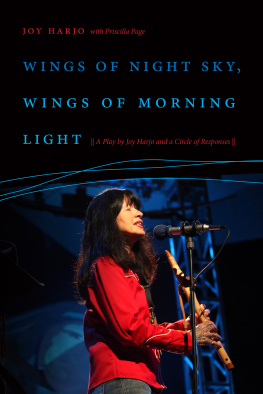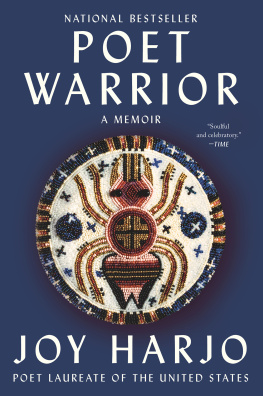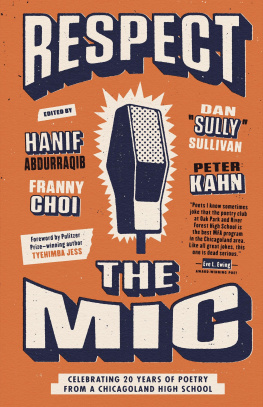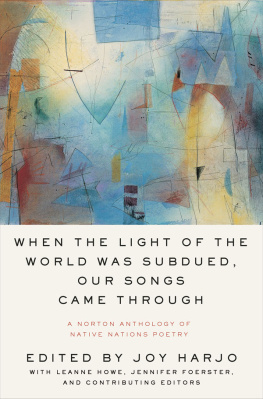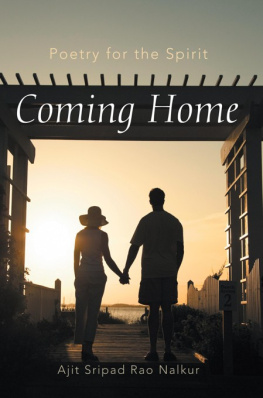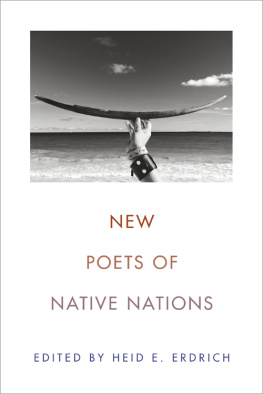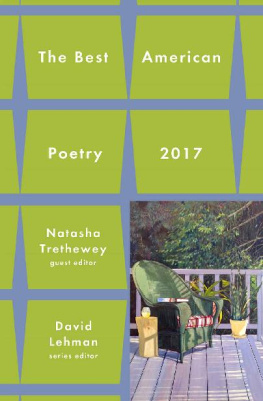CATCHING THE LIGHT
CATCHING THE LIGHT
JOY HARJO

The Why I Write series is published with assistance from the Windham-Campbell Literature Prizes, which are administered by the Beinecke Rare Book and Manuscript Library at Yale University.
Published with assistance from the Mary Cady Tew Memorial Fund.
Copyright 2022 by Joy Harjo.
All rights reserved.
This book may not be reproduced, in whole or in part, including illustrations, in any form (beyond that copying permitted by Sections 107 and 108 of the U.S. Copyright Law and except by reviewers for the public press), without written permission from the publishers.
Yale University Press books may be purchased in quantity for educational, business, or promotional use. For information, please e-mail (U.K. office).
Library of Congress Control Number: 2022934816
ISBN 978-0-300-25703-8 (hardcover : alk. paper)
A catalogue record for this book is available from the British Library.
This paper meets the requirements of ANSI/NISO Z39.48-1992 (Permanence of Paper).
CATCHING THE LIGHT
I do not know when the first poem was, where it came from, or exactly how. I just know how much I needed it: the scrawl, the questioning, the words lining up in a musical sound sense to make something from the everything of nothing. I was in the dark and decided to investigate the dark to find the light.
I write to you now from Tulsa, Oklahoma, from the Mvskoke Creek Nation Reservation. We are at the border of three Native nations that also include the Osage and Cherokee. We honor and acknowledge those original keepers, past, present, and future, who care for these lands. We acknowledge the source of the gifts of our living, for without this Earth, or Ekvnvcakv, we would be without shelter, clothing, food, or inspiration. Consider that the Earth mind, architectures, and aesthetics shape the mother root of our imagination here.
Vkvsamet hesaketmese pomvte. Mowe towekvs pokvhoyen yiceyvte
Mon vkerrickv heren. Pohkerricen vpeyeyvres
It was fifty years ago that I began this word venture, as an undergrad student at the University of New Mexico, a single mother with two children (and sometimes three), who went to school full-time, starting out as a pre-med major with a minor in dance, and changing the first year to studio art, my original career intent. I became involved with the Native student club, the Kiva Club, and met real Native poets and writers like Simon Ortiz and Leslie Marmon Silko.
I was introduced to the writing community in Albuquerque through Simon and Leslie, and through the stream of performances and activity at the Living Batch Bookstore across Central in front of the university, and through the English Department, which hosted a series of poets ranging from Galway Kinnell, whose poem The Bear gave me permission to write toward transformation, to Ai, whose mysterious yet eyes-wide-open poems made a road that led to bravery.
It was in the lands of the Southwest that poetry found its way to me, in words that were given context and lift from red mesas, pion trees, and a light filtered by mountains, where so many left prayers through eons of history. The Southwest taught me an attention to light, to the arrangement of mountains and high plains. I could see the sky and even beyond the sky. And I was coming to learn that words were ladders, with each rung leading between the darkest of hours to sunlight, from confusion to accomplishment, or in the opposite direction.
I worked long hours with my research position at American Indian Studies, and my full-time slate of classes, and the day-to-day childcare. The night became my solitude. I have always needed solitude, yearned for it when it was scarce. Id stay up nights painting and drawing, and then poetry elbowed its way in, when I thought I had no more room. My long nights then became a tug-of-war between poetry, artwork, and figuring out how my little family would make it on nearly nothing. My first poems were published a year later. In 2022 it will be fifty years since my first published poems.
This treatise will be something of a journey, about the why of writing poetry. There will be fifty vignettes, some poem-centered; others are points of illumination or questioning. In these fifty years, I have come to conclude that, ultimately, it is about catching light in the dark. Poetry (and other forms of writing) can be useful as a tool for finding the way into or through the dark. Or a device with which to admire the complexity of the stories in which we have become entangled. Sometimes the only way out is by voice, following the music into the impossible.
1
When my third granddaughters body was forming, I watched and listened to what was going on in the atmosphere, to find a clue about this incoming family member, what she would need once she arrived here to take on her part of the story.
A powerful story was making the rounds in the Native community where I was living in New Mexico. There was a Navajo woman of a righteous nature who lived far out on the reservation in a hogan, the traditional home of the Navajo, or Din people, there. She still prayed every morning with cornmeal, tended the altars of the living, took care of her sheep, and was loved and well respected by her relatives and neighbors. She was also blind. She was visited one day by the Holy Ones. As her hogan filled with the powerful presence of sacredness, the Holy Ones told her, as they towered over her, that they had come to give a warning to the people.
We are nearing times where we will experience Earth changes, famine, and strife, because people are forgetting their original teachings.
The Holy Ones instructed her to tell everyone to keep hold of their traditional ways, which meant attending to prayer and minding their attention in all things, because it matters for the outcome of the people, for all life forms on this Earth. Without it, they will suffer.
The traditional ways and rituals of all of Earths peoples are kept in containers of poetry, song, and story. It is how we know who we are, where we are coming from and who we are becoming.
I knew that my granddaughter was bringing in special gifts that would assist with these times we are moving into, times in which we are reckoning with our lack of respect and attention to what matters in this place.
I told this story at a performance in Flagstaff, Arizona, near one of the sacred mountains. Many of the Din people there nodded their heads in remembering. For Holy Ones to touch down in that manner is powerful and dangerous; everyone must pay attention.
Afterward one of the women came up to me and remarked, I saw the footprints of the Holy Ones in the sand in front of the hogan! They were very long and narrow.
The times the Holy Ones spoke ofwe are now in those times. In this time at the crossroads of brokenness, we are watching and listening for what stories will nourish us.
At this cliff edge of becoming, there will be no turning back.
These are the times that invite tricksters who disturb the waters. It was in a time like this that Robert Johnson, blues guitarist, met the devil at the crossroads one humid night somewhere in the dark of history. It is in times like these that we face the most cunning of tricksters. We might even find a trickster in the seat of power. We have always had clowns and tricksters in every culture. They inhabit the power places because their role is to remind us that though we may hold and even wield power, power does not belong to us. It is meant to be shared.
2
This morning, an old friend from my days in the Kiva Club sent me an image. It is morning in Lukachukai, a mountainous region on the Navajo Reservation marked by pion pines and mesa vistas. His sister is warming the truck before they take it down the mountain for their jobs. I smell strong coffee, hear the radio static in Navajo language from the trucks dash. A misty female rain has been brought as a gift from the sky to Earth. When he writes to me via FB Messenger, he writes in prayer language. By prayer language, what I mean is that there is attention to the atmosphere of place and time, and how language is happening. Language is a living being. It is feeding this image, giving it a place to live in my imagination, even as the image calls forth language to speak on behalf of the beauty weaving the mountain and the sky, the beauty being breathed by my friend, his sister, and the livestock.
Next page

